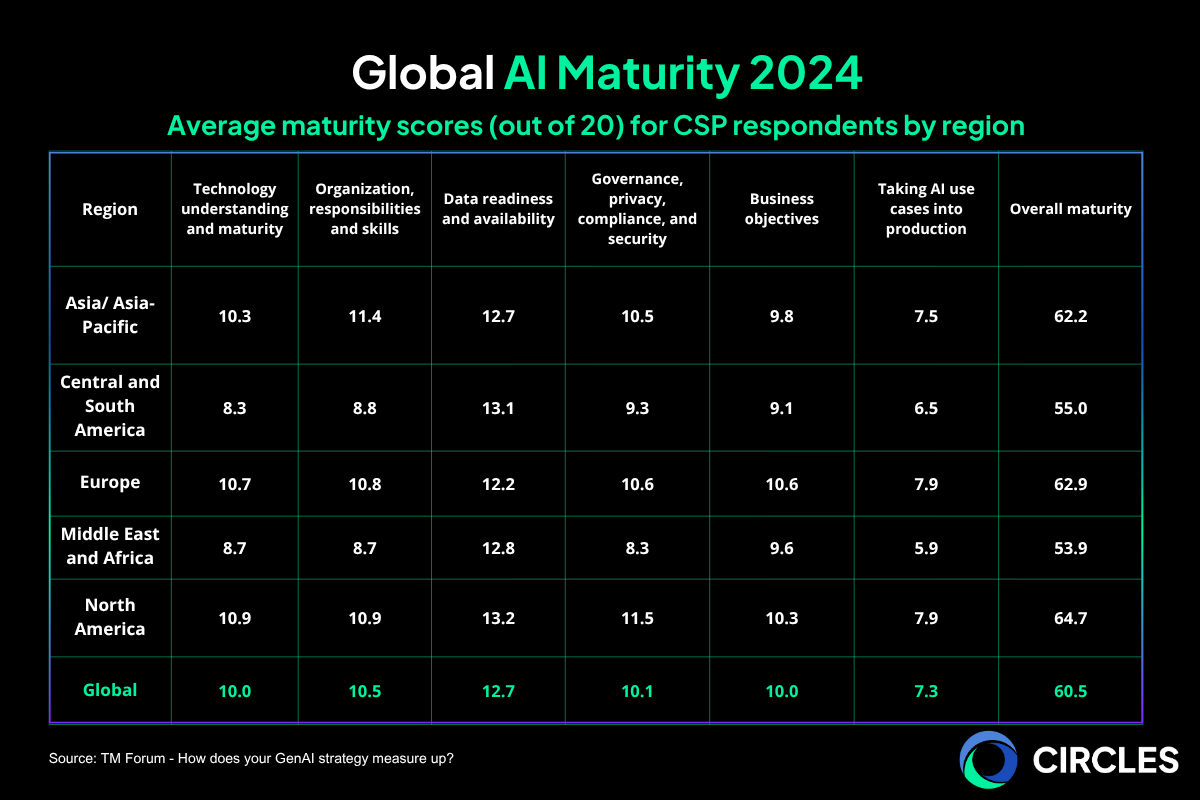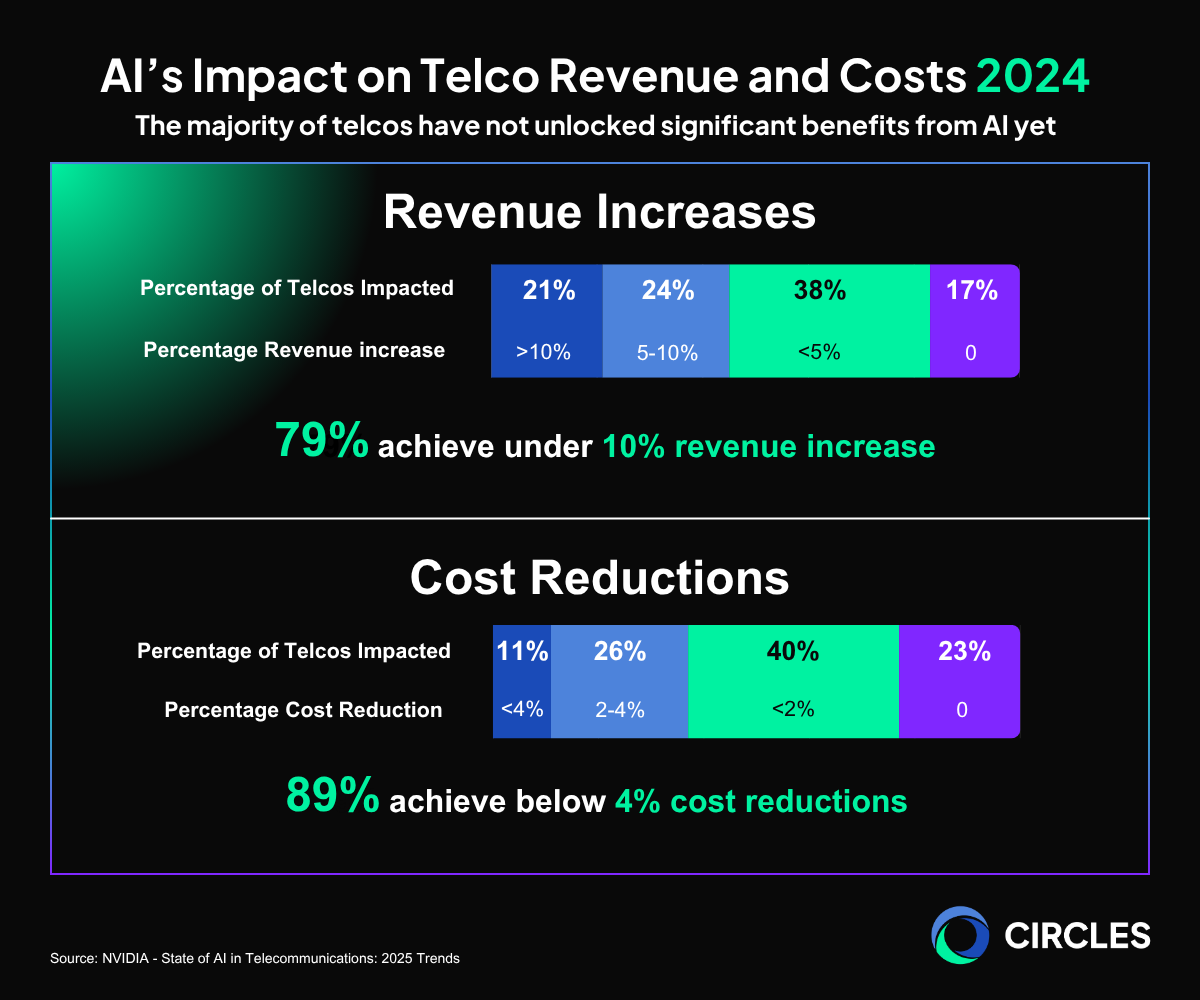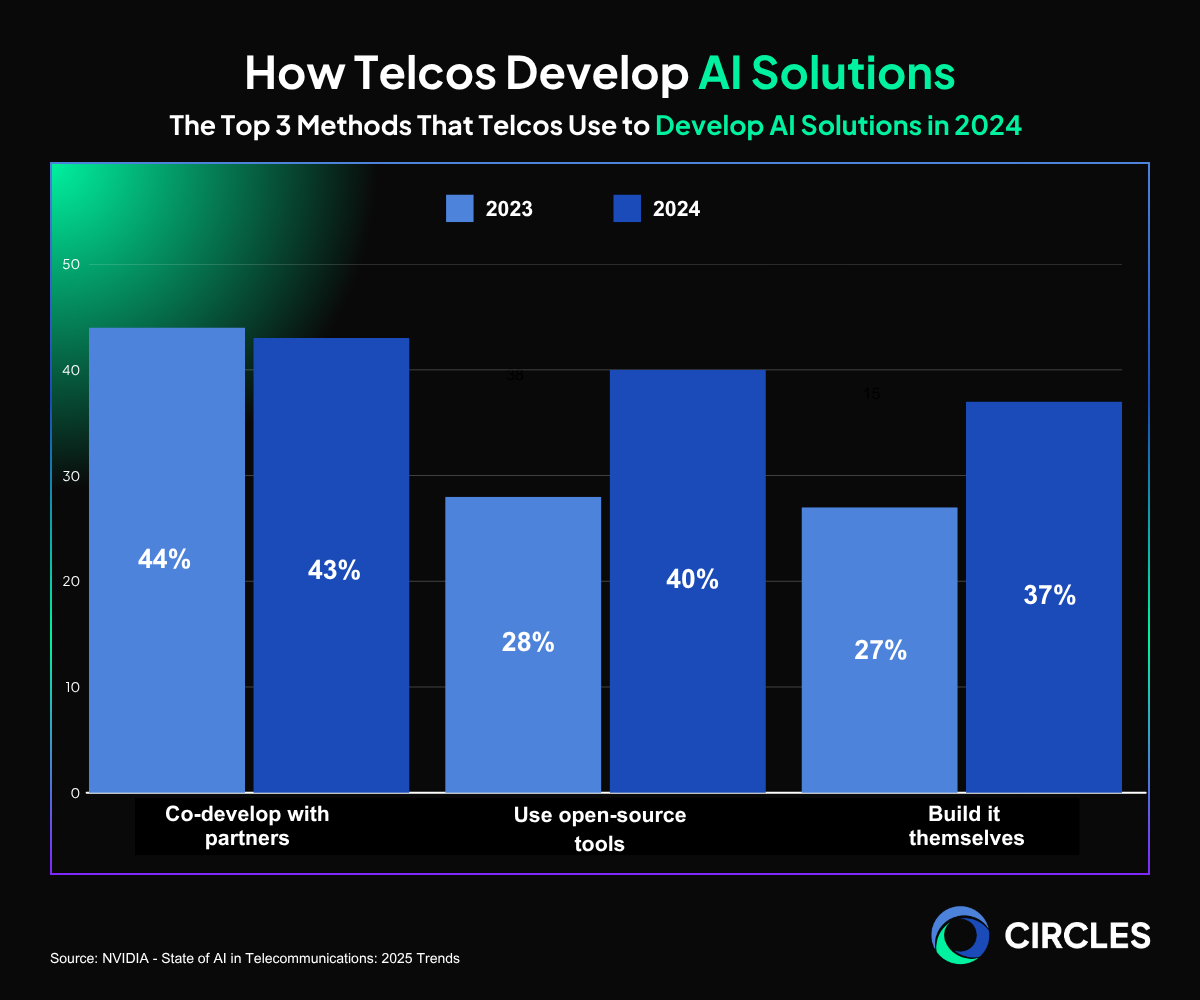

There are currently no clear winners in the telecommunications AI adoption race yet, but there is now greater urgency for laggards to catch up.
In our AI maturity article, the benchmarks show an industry that is both energized and constrained: energized by wins by telco leaders, yet constrained by low investment, fragmented data, and limited scaling. Almost every telco CEO sees that the value in AI is real, but capturing that value requires sharper prioritization and a more purposeful approach to maturity.
This post looks into common telecommunication AI maturity gaps and what telcos can do to plug them and accelerate their AI adoption journeys.
The Average Telco is Not Behind, But The Window Is Closing
With 60 percent of operators still at the proof-of-concept stage, there is a growing gap between leaders and laggards. Leaders like AT&T1, Verizon2, SK Telecom3, and Vodafone4 are scaling up their initiatives that improve metrics like NPS and customer lifetime value. Smaller and less mature operators risk being structurally disadvantaged: without scale, the talent, data, and governance capabilities required to catch up are expensive to build, and customers are unlikely to wait.
AI maturity is turning into a competitive benchmark, and those who delay risk getting left behind. Late movers who delay too long may find themselves competing against players who have already embedded AI at scale.

Plugging Structural Gaps is Key to Catching Up
Smaller and less mature operators risk falling further behind if they are not able to get the capabilities needed to catch up with AI mature telco leaders.
The biggest barriers are structural. Without addressing them, scaling AI beyond chatbots and marketing pilots will remain out of reach. Three hurdles stand out:5
Solving these means plugging tech, talent, and strategy gaps that can either be built in-house or developed with partners. But before considering whether to build or buy these capabilities, having a clear vision and objective for the telco’s AI future is needed.
Having a Holistic, Strategic View on AI Project Outcomes is Key
NVIDIA shows that 79 percent of operators have realized less than 10 percent revenue uplift from AI.2 This validates the gaps that TM Forum’s survey has shown and also highlights that many AI experiments could have led to disappointing results.5
TM Forum’s report also mentioned: “Indeed, we have spoken to many operators which have been disappointed by the results from early GenAI use cases and which, as a consequence, are struggling to win internal buy-in for new projects.”

CEOs are already tying clear business objectives to AI projects such as improving churn, customer lifetime value, or operational efficiency. But tying these projects in a holistic way as opposed to running individual projects that risk being easily scrapped could be a way to keep momentum and buy-in for AI projects going.
Working with strategic partners with proven use cases could help to shortcut the process, and help telcos overcome the disappointment of their own trial and error phases quicker.
In short, AI adoption requires a clear vision of the end results it should achieve and a holistic approach to building the telco’s AI maturity across various pillars. CEOs need to balance both near-term returns and long-term capability building.
Closing the maturity gap will require targeted investments or partnerships to build up their data, skills, and governance while accessing proven strategic AI transformation playbooks. This also needs to be combined with disciplined scaling of proven use cases. Without building these firm foundations, telcos will continue to spend opportunistically on pilots that may not move the needle on operational efficiency or value creation.
The Benefits of Co-developing With Strategic Partners: Speed, Tech, & Proven Playbooks
Accessing an external party’s resources can plug telcos’ maturity gaps and help them catch up with AI leaders. This approach is already being used by nearly half of all telcos, with 43 percent of telcos co-developing their solutions with partners.

This is especially helpful for those that are very early in their development as building everything in-house is neither realistic nor efficient. Strategic partners can offer proven AI platforms, tested governance frameworks and access to scarce AI talent, helping telcos adopt AI with lower risk. Partnerships provide a few accelerators:
Speed and Platform Readiness:
Working with strategic partners lets telcos leapfrog onto proven AI platforms without needing to build new AI-ready platforms from scratch.
Moving onto an AI-enabled fullstack solves data silo issues. By having all data within a single stack, this software platform turns into a single source of truth for faster and sharper intelligence. This approach enables autonomous decision making and operations, customer experiences that anticipate customer needs before they happen and eventually the development of new business models and diversified revenue streams.
The AI-enabled fullstack is also the approach that partners like Circles use. Unified data intelligence lies at the core of the tech stack, providing a single source of truth across acquisition, operations, and engagement.
To keep the platform relevant, efficient and competitive, Circles also works with leading AI partners like OpenAI and incorporates their products automatically into the platform. Designed to provide operators with immediate access to global AI innovation, it removes the delays of traditional procurement and integration and accelerates innovation and business outcomes. On top of that Circles has proven data migration capabilities to keep the transition to the new AI stack smooth and low-risk.
Holistic Strategic Planning to Justify ROI and Avoid Ad-hoc Experiments
Telcos can look out for partners that build their AI capabilities with a holistic view based on improving business performance such as cost reduction, improving customer experiences, and more. The right partners would also have done their due diligence in selecting the right LLMs and using the right techniques to get the best results from their AI platform.
These approaches avoid the issue of building opportunistic, siloed AI projects that can end up easily abandoned, wasting resources and saving telcos years of trial and error and development time.
Partners, like Circles, activate four key levers of AI value: cost reduction, revenue growth, improved NPS, and new monetization models. With hyper-personalized plans, intelligent customer agents, AR wearables, e-commerce, and AdTech integrations, operators can enhance customer experiences, reduce churn, and build long-term value. New AI products are also tested in real-market conditions where winners are quickly scaled, enabling telcos to see results faster and better justify ROI.
Talent, Capability, and Governance
Working with hyperscalers and AI specialists can grant telcos scarce GenAI skills, including prompt engineering and MLOps along with tested governance frameworks for responsible AI to reduce regulatory and reputational risks. Partners that have a global footprint and proven track records can guide telcos through their AI transformation using proven strategies and playbooks.
Strategic telco partners like Circles provide proven digital transformation playbooks that are built by operators for operators ensuring relevance, speed, and scalability. These have been validated through deployments with leading global telcos like AT&T, KDDI, and e& while applying experience gained from running its proprietary mobile brand, Circles.Life.
All of this lets Circles bring learnings from one market and scale quickly to others, accelerating the proof-of-concept stages and bringing more products into production quickly. This is also supported by Digital Advisory Support Services (DASS) consultants who are ready to provide AI implementation expertise that enhances operations efficiency and improves customer experiences.
Proven governance guardrails are also put into place. For example, any AI decision that touches money, privacy, or QoS is auditable in-app and regulator-ready. There are also safety nets and human-in-the-loop approaches where automated guard-rails (fair-use, bias checks) plus easy escalation to humans for edge cases are available.
The journey to making your telco AI mature could be daunting, but it’s not too late to catch up and you don’t have to go it alone. Working with strategic partners helps your telco lower its risk while gaining valuable experience to help your telco catch up with more AI mature leaders.
When selecting your partners, look out for those with experience in digitally transforming some of the largest global telco players while also piloting the launch of AI capabilities around the world. Circles has experience digitally transforming leading telco brands from around the world, and was also the main partner in the launch of KDDI’s povo AI in Japan, giving your telco access to a pool of experienced global talent.
By working with Circles, your telco can access a full-stack, AI enabled platform where all data is on a single stack - removing data silos while making your telco’s data AI-ready. On top of boosting your telco brand’s AI capabilities, Circles can holistically turn your telco into a techco by covering every digital transformation step from market research, and branding, to go-to-market strategies to hit tech savvy telco customers through their Digital-as-a-service capabilities.
Leapfrog ahead of the competition by contacting us to find out more about how Circles can help your telco become future-ready AI techco.
References:
- AT&T Transformed into an AI Company with H2O.ai
- Verizon uses GenAI to improve customer loyalty | Reuters
- SK Telecom enhances customer support for millions of Koreans with Claude in Amazon Bedrock
- Meet SuperTOBI - Vodafone’s new Generative AI virtual assistant now serving customers in multiple countries
- TM Forum - How does your GenAI strategy measure up? Key findings from our Generative AI Maturity Interactive Tool
